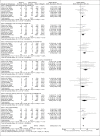Comorbidities and severity of coronavirus disease 2019 patients
- PMID: 33130835
- PMCID: PMC7804237
- DOI: 10.15537/smj.2020.11.25454
Comorbidities and severity of coronavirus disease 2019 patients
Abstract
Objectives: To determine the association between comorbidities and the severity of the disease among COVID-19 patients.
Methods: We searched the Cochrane, Medline, Trip, and EMBASE databases from 2019. The review included all available studies of COVID-19 patients published in the English language and studied the clinical characteristics, comorbidities, and disease outcomes from the beginning of the pandemic. Two authors extracted studies characteristics and the risk of bias. Odds ratio (OR) was used to analyze the data with 95% confidence interval (CI).
Results: The review included 1,885 COVID-19 patients from 7 observational studies with some degree of bias risk and substantial heterogeneity. A significant association was recorded between COVID-19 severity and the following variables: male (OR= 1.60, 95%CI= 1.05 - 2.43); current smoker (OR=2.06, 95%CI= 1.08 - 3.94); and the presence of comorbidities including hypertension (OR=2.05, 95%CI= 1.56 - 2.70), diabetes (OR=2.46, 95%CI= 1.53 - 3.96), coronary heart disease (OR=4.10, 95%CI= 2.36 - 7.12), chronic kidney disease (OR=4.06, 95%CI= 1.45 - 11.35), and cancer (OR=2.28, 95%CI= 1.08 - 4.81).
Conclusions: Comorbidities among COVID-19 patients may contribute to increasing their susceptibility to severe illness. The identification of these potential risk factors could help reduce mortality by identifying patients with poor prognosis at an early stage.
Figures





References
-
- Khot WY, Nadkar MY. The 2019 novel coronavirus outbreak-a Global threat. J Assoc Physicians India. 2020;68:67–71. - PubMed
-
- Callaway E, Cyranoski D. China coronavirus:six questions scientists are asking. Nature. 2020;577:605–607. - PubMed
-
- World Health Organization. Coronavirus disease (COVID-2019) situation reports-94. [Accessed: 2020 April]. [Updte 2020] Available from URL: https://www.who.int/emergencies/diseases/novel .
Publication types
MeSH terms
LinkOut - more resources
Full Text Sources

